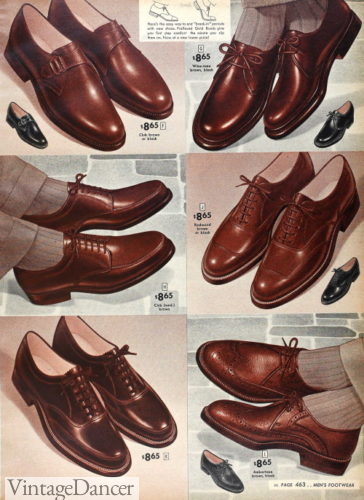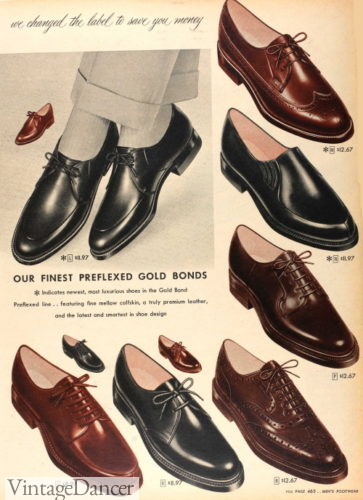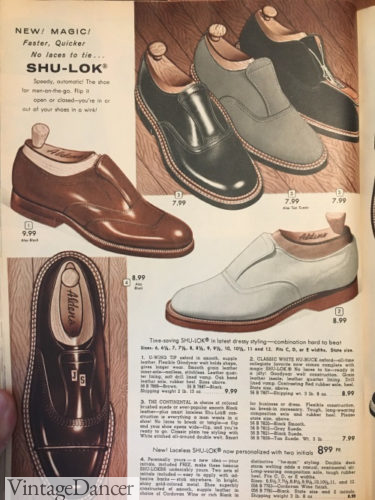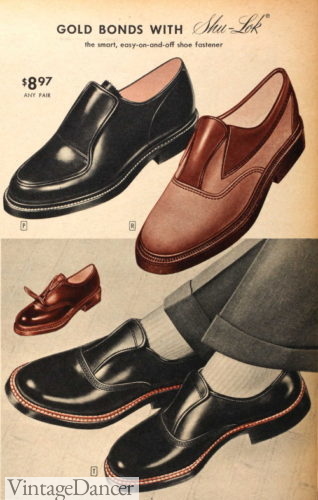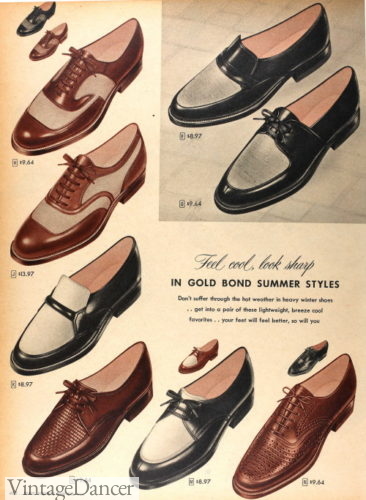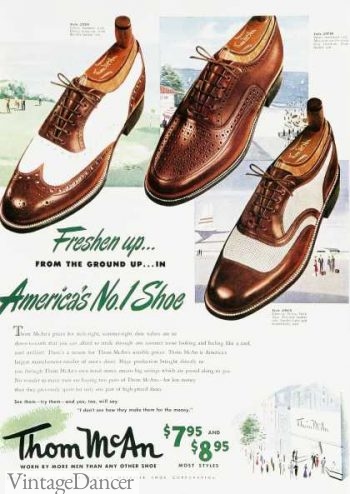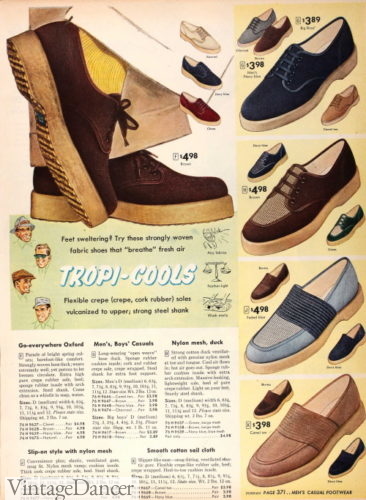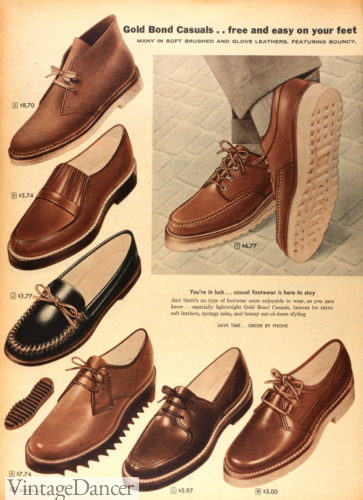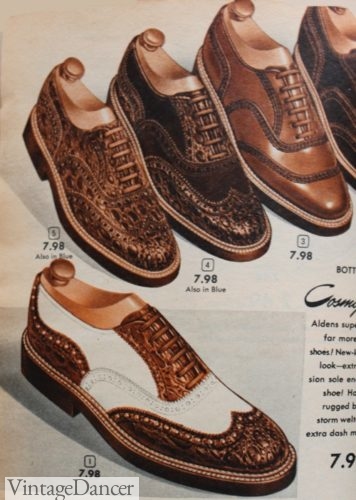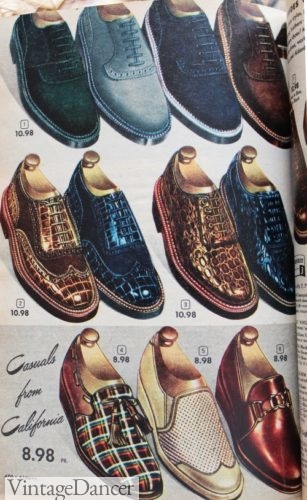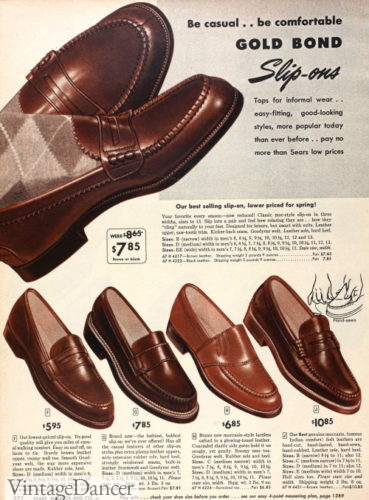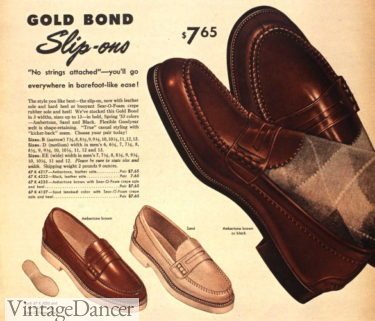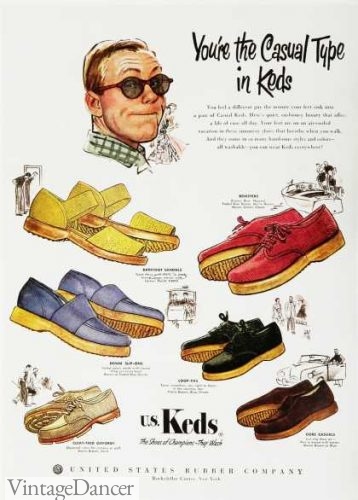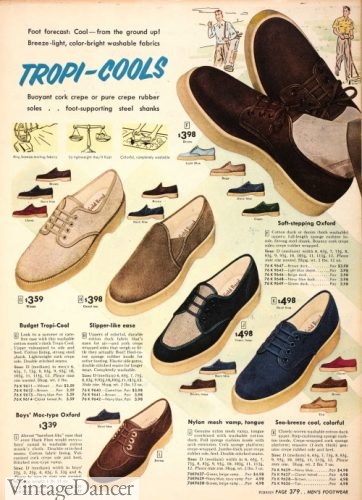The 1950s expanded on the trend of “American informal” fashion. This comfortable new look encouraged everything from hats to shoes to slim down, loosen up, and mix up color and texture.
For men’s 1950s shoes, that meant classic men’s footwear such as Oxfords, loafers, and boots were all modified to include thicker soles and a narrower silhouette, offered in primary colors such as blue, green, and grey and in textures such as reptile skin, suede, woven leather, mesh, and heavy fabrics.
None of these details were new to men’s footwear, but when combined with each other, created a decade of casual sophistication.
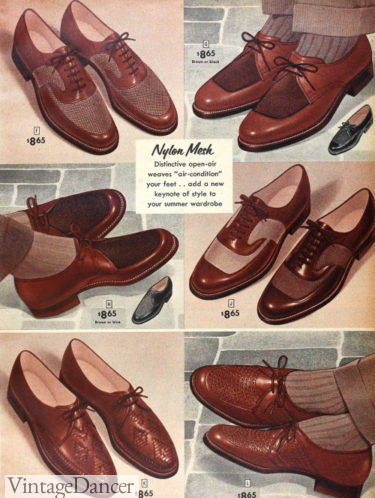
1955 men’s leather and fabric two-tone shoes
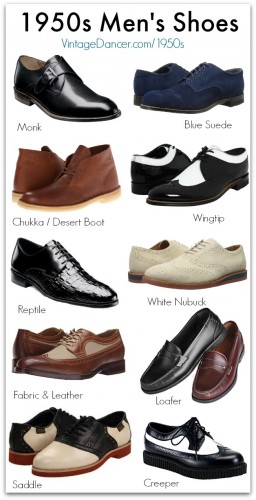
1950s Style Men’s Shoes- Buy Now
1950s Men’s Oxford Shoes
The lace up dress shoe that had been every man’s staple since the turn of the century was still the leading footwear style of the 1950s. The 1950s versions incorporated previous decades styles as well as some new variations.
Men’s 1950s dress Oxfords, derbys, and bluchers (what’s the difference?) had a smooth body or were perforated with a simple cap toe, moc toe, or elaborate wingtip design. Medium brown was the most versatile color while dark brown and black were options as well. Soles matched the body color in either leather or rubber.
- 1955 oxford shoes
- 1957 continental shoes with two eye-laces
Full lacing was the most traditional, but more and more men in the late 1950s preferred the “continental” two lace closure. It made these classic shoes much more streamlined and faster to tie.
Among men’s 1950s dress shoes, there was also a full slip on shoe that did not have any laces. Instead, panels of elastic lined the inside, stretching open to slip the shoe on easily and closing up tight to keep it in place.
There was also the classic men’s loafer shoes in the 1950s, especially made in shiny black leather. The lack of laces made them the most un-decorated of men’s 1950s dress shoe styles. The crossing of the line between dressy-shoes and casual-shoe only grew as the decade progressed.
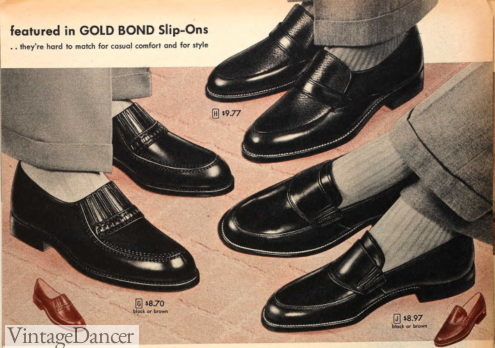
1957 slip-on dress shoes
In the late 50s there was also a lace-less shoe called the Shu-lok, Snap Jack, or flapjack shoes. It has a tongue that snapped up to slide the foot in and snapped down to lock it in place.
Shu-lok was invented in 1954 but became more popular in 1956-1960. It was marketed at first to elderly men and then to children and teens. Black was the most common color but brown, two-tone saddle, and white nubucks were each adapted to the design.
There was another snap buckle closure called a snap-latch that was made of a single strap around the top. By 1959 it was replaced with Velcro as a faster and cheaper way to close a shoe without laces. Shu-loks continued to be made into the ’70s.
- Shu-lock snap in tongue slip on shoes
- 1957 men’s Shu-lock shoes
1950s Men’s Two Tone shoes
As for casual style Oxfords, there were many more choices that experiment with color, texture and design elements. Two-tone fabric and colored leather were common in the early ’50s.
Tone on tone fabric and leather (usually brown) continued in the later years. Grey suede, cream, and buttery-tan each made contributions to the summer color palette.
- 1957 two-tone shoes
- Thom McAn 1950s mens two tone shoes
For most of the 1930s to 1940, two-tone shoes were worn equally with suits as they were casual outfits. The 1950s continued the trend with two-tone wingtips, cap toes, loafers and moccasin top styles.
I noticed there are greater amounts of white on 1950s two-tone shoes than the previous decades. Also, the black and white two-tone Oxford was more common in the 1950s.
Hollywood stars frequently wore black and white patent leather shoes while dancing across the silver screen.
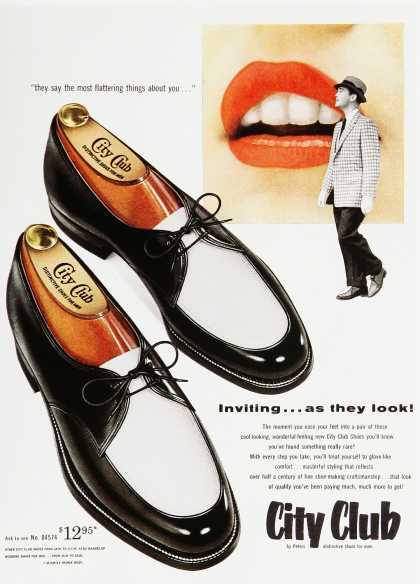
Two-tone two lace shoes, late 1950s
Two-tone 50s shoes mixed with other shoe styles as well such as penny loafers, tassel loafers, boat shoes, two-lace dress shoes, and occasionally boots.
A very popular two-tone look was not two colors of leather but two contrasting materials on one shoe.
Especially in summer, men’s shoes combined leather and mesh or smooth leather and perforated leather for breathability. The leather was usually darker than the inset mesh or in a different color entirely.
Blue or green with grey mesh was trendy. Brown on tan was the most versatile. White on white was ideal at the summer seaside.
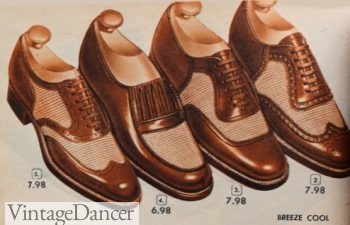
1952 men’s leather and mesh combined shoes
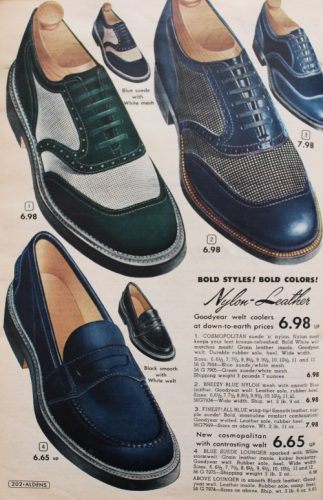
1953 mens shoes in blue and green mixed materials
In winter, two types of materials were mixed to create a similar look. Leather was combined with heavy wool fabric (waterproof too), or mixed with suede, embossed leather, reptile, or other thick textures. The mixing of smooth and rough textures and shade of colors is very iconic of 1950s men’s shoe styles.
1950s Men’s Saddle Shoes
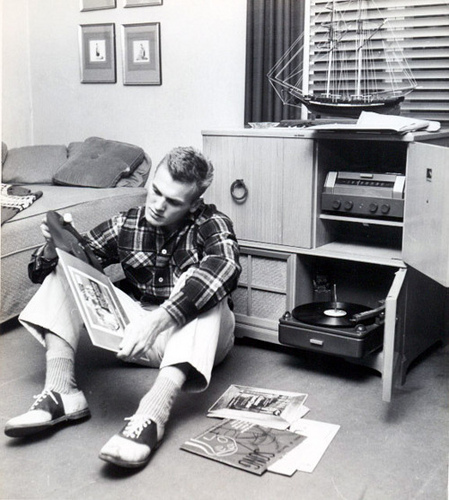
Young man in saddle shoes
The black and white saddle Oxfords had been in style since the 1920s, yet everyone associates them with the 1950s. Both female and male teenagers and college kids favored these comfortable shoes that had to be kept perfectly clean and un-worn.
Older generations also wore them, usually in brown and white combinations instead. Some dressier versions also came in brown on brown, brown on tan, or any other two shades of the same color.
Learn more about the history of 1950s saddle shoes.
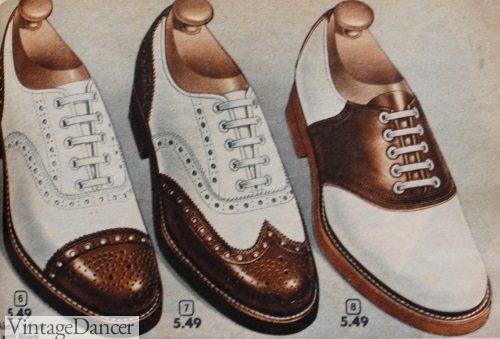
1952 two-tone cap toe, wingtip and saddle shoes
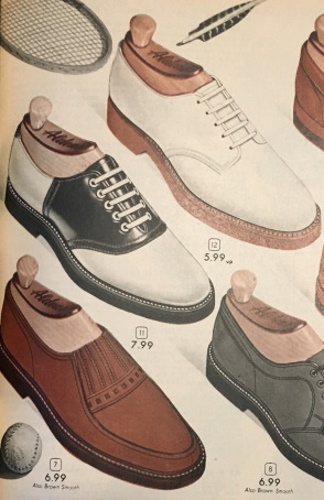
Black and white saddle shoes for teens
1950s Men’s Blue Suede Shoes
Combining a “new” color as well as texture introduced the blue suede shoe. Suede Oxfords came in other vibrant colors too, such as hunter green, sky blue, smoky grey, and chocolate brown.
Blue was the most popular color for 1950s shoes such as oxfords, slip-on loafers, saddle shoes, and pretty much any other kind of casual shoe.
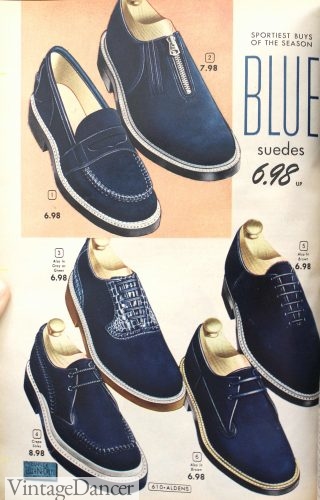
Blue Suede shoes
Why blue? Long before Carl Perkins wrote the famous “Blue Suede Shoes” sung by Elvis, there was an explosion of blue shoes for sale in the early 1950s. It was during this time that Perkins overheard a young man say something like “stay off my blue suede shoes” to his girlfriend.
Suede is difficult to keep clean. Being stepped on left a dust mark that was unacceptable to fashionable young persons. Years later, Perkins was reminded of this incident and wrote his hit song about it.
At the time, neither Perkins nor Elvis owned a pair of blue suede shoes. Elvis did buy one pair after the huge success of the song to wear on stage. There was a small revival of blue suede shoes in the late 1950s because of the hit song.
Back to my original question: why blue? I have yet to find the answer, but I am determined to do so.
Nubucks and Crepe Soles
On college campuses, students and faculty favored white nubucks with red rubber soles in summer. Nubucks or just ‘bucks were popular summer shoes for most of the 1920s onward.
Similar to suede, the finish was a sanded leather, making them more durable than soft suede shoes. They could come in various shades of light brown, but in summer they had to be white or ivory.
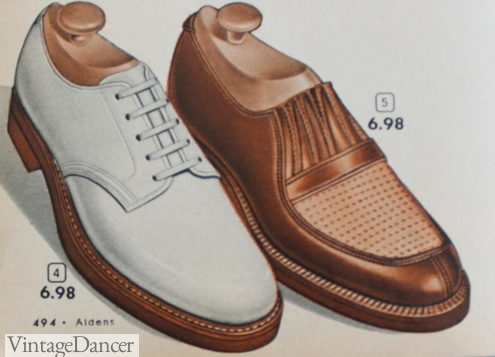
1951 white nubuck shoes
The red rubber sole was a new look in 1950s shoes. They were usually combined with saddle shoes, nubucks, and other casual Oxfords in light colors. The blast of red stood out, calling attention to men’s footwear. The rebellious teen loved anything that was new, different, and bold.
- 1954 crepe sole casual canvas shoes
- 1958 Crepe Sole Leather Shoes and Chukka Boots
Less bold but certainly different was a new kind of sole- the crepe sole. It was a thick natural colored nubby rubber sole paired with casual oxfords, loafers, and sport shoes. Some boots like the Chukka had them, too.
The crepe rubber made them comfortable to walk in, durable, and non-slip. Knock off designs featured a dense foam cushion with classic crepe groves on the sole.
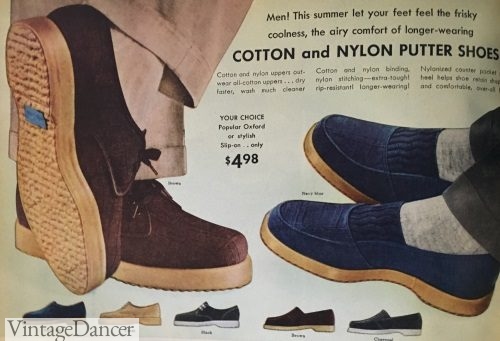
1956 crepe sole casual shoes
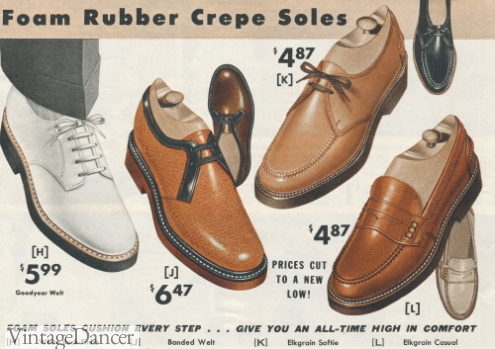
1955 crepe foam sole casual shoes
Just like the red colored sole, natural colored crepe soles had to contrast with the shoe body to stand out. Chocolate brown, blue, grey, or matching tan shoes were the best choices.
Reptile Skins and Western Prints
Suede and nubuck was popular because of the rough texture and anything with texture was in fashion in the 1950s. Reptile skin, which had been used during the war years as an alternative to leather, returned to fashion in the early 1950s. Big skin prints were favored over smaller skins. Alligator print was the most common skin, both real and fake.
Similar to reptile skin were embossed leather shoes. These were most associated with Western style men’s shoes or California ranch style. Some had silver monk strap buckles to mimic Western belt buckles. Embossed patterns could be Western themes or native American prints.
- 1952 reptile brown oxfords
- 1952 colored reptile skin shoes
Western boots remained popular for cowboys or those who choose to dress like California ranchers in the City.
1950s western boots had decorative shafts, block heels and sharp pointy toes. Tone on tone colors was more popular in the 1950s whereas early decades mixed bright red, white and silver into flashy designs worthy of a rodeo star.
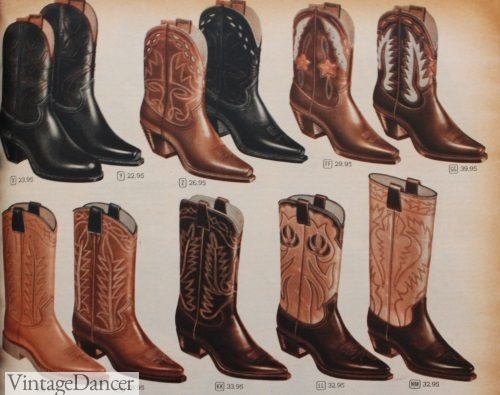
1955 men’s Western boots
1950s Men’s Loafers
Moving away from casual lace up Oxfords, men pursued more ease and comfort with a loafer. Loafer styles could be the ‘40s classic penny loafer, tasseled loafer, moccasin, or elastic slip-on.
Men’s 1950s loafer shoes could easily be slipped into without the need to tie them. They were the ultimate casual shoe that was quickly replacing lace up dress shoes in most fashion settings.
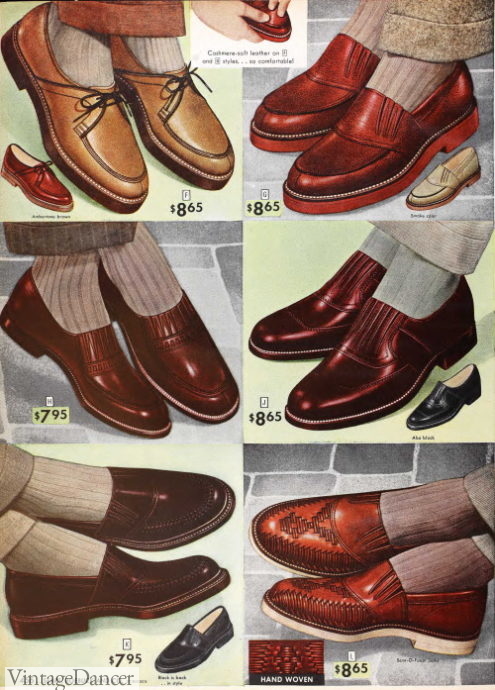
1955 slip-on loafer shoes
The classic penny loafer remained popular in the early 1950s as it had been in the 1940s without much change. Brown or black penny loafers were worn on college campuses (with crepe soles), with summer sport clothing, and with semi-casual sport coats and blazers.
The dressed-down look that dominated most 1950s men’s fashion paired very well with slip-on loafers.
- 1952 penny oafers
- 1953 penny loafers
The tasseled slip-on loafer was a big trend with some men. It came with a lightweight single sole and a leather body, or a body of leather mixed with suede or reptile prints with two tassels tied and dangling on top. The tassels gave the loafer a bit more elegance and versatility to crossover into men’s business wear.
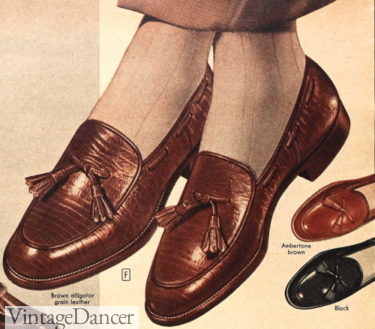
1953 men’s tassel loafer reptile alligator shoes
Tassels originally appeared on moccasin style boat shoes, which were still in fashion in the 1950s. The woven leather treatment on loafers were inspired by men’s sandals. The created a breathable summer shoe that was more popular than beach sandals.
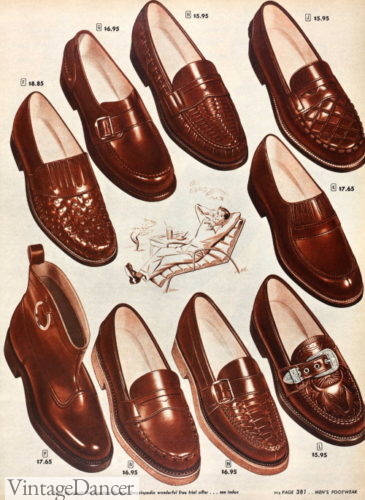
1950 woven leather summer loafers
Men’s 1950s Sneakers
The high top Converse “Chucks” sports shoe in the classic black and white combination was released in 1949. It was the professional sports shoe choice for basketball and baseball players and most high school and college sports as well.
To wear them in school was a status symbol either as an athlete or a rebel. They were a favorite of the most notable rebel James Dean.
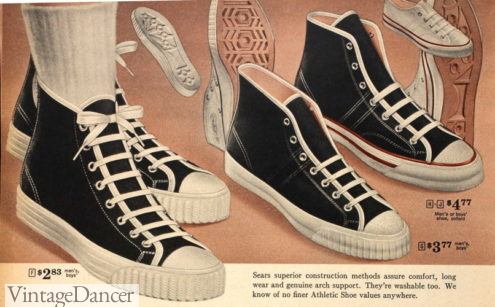
1959 Jeepers brand sport shoes
In 1957, the low cut Converse All Star was introduced to appeal to the mass market of kids already wearing “sneakers” as daily wear. They were very well received. Converse dominated 80% of all sport shoes sales in the 1950s.
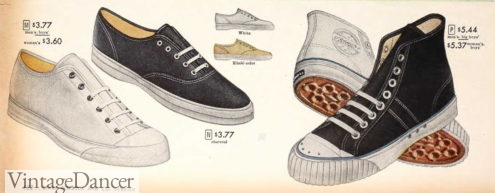
1957 canvas sport shoes
Knock -off brands like Jeepers, were plentiful, and not just in the classic black and white pattern. All white was required for many school’s gym uniforms. Dark grey or tan low-top tennis shoes were a favorite for casual outfits.
1950s Men’s Sandals
Men’s sandal styles remained unchanged from recent decades. All leather is woven all over the toe with a T-strap or single strap and side buckle. The weave could be tight like earlier years but the ‘50s style favored a larger weave with more space in between layers for breathability. Instead of a weave, some had large cutouts in the toe box.
Sandals were worn with socks (oh, the horror!) and were not very popular yet as a shoe choice, even in summer.
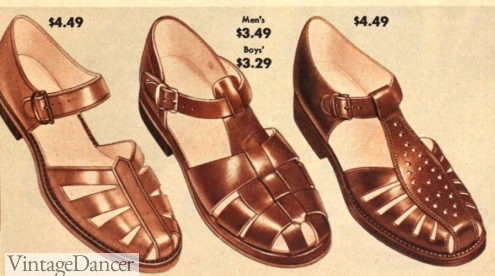
1951 men’s sandals
Besides sandals most style of men’s casual shoes were made in lighter canvas type fabrics with thick soles. They came in nearly any color imaginable but neutral colors were the best sellers.
- Keds summer shoes
- 1953 Tropic-cool summer shoes
Men’s House Slippers
The slip-on shoe continued to be worn at home in the form of house slippers. Most men cast off whatever shoe they were wearing during the day and put on a pair of house slippers to wear for the remainder of their day.
Smooth, plain leather slippers with deep notches on the sides were the most common. Many had elastic between the notches for a better fit.
The plainness of the slipper contrasted heavily against flashy daytime shoes. Even men needed a break from forward-thinking fashion sometimes. Shop men’s slippers and see more examples of vintage slippers.
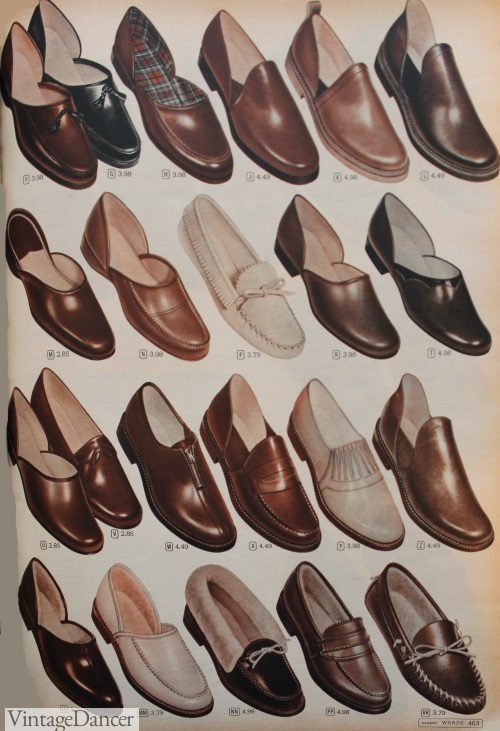
1954 Men’s house slippers
1950s Men’s Boots- Rockabilly Shoes
For rebellious youths who would eventually inspire rockabilly fashion today, the choices of footwear were vastly different than the classic styles listed above. With the exception of Converse sneakers, rebels looked for unique shoes not readily available on the mass market.
1950s men’s boots were one such shoe style that most men avoided unless it was for a labor job. Boots were not for fashion — they were practical, necessary, and designed specifically for a physical task.
1950s Work Boots – read more about men’s working boots and shoes here.
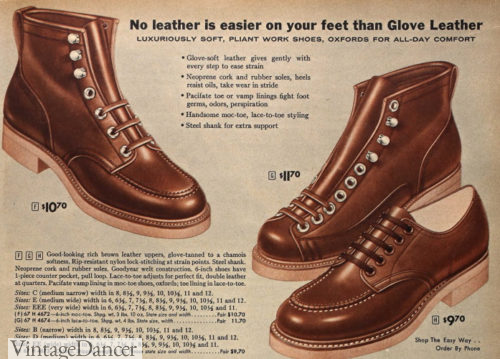
1958 cork rubber sole work boots and shoes
Motorcycle boots protected men’s feet and legs from road grime. They were called Engineer boots and were originally designed for firemen working the railroads shoveling coal into hot burners. The boots were a cross between logger boots and riding boots with a tall shaft and a belt and buckle around the ankle and on the upper outside shaft.
It was the perfect boot for motorcycle riders since there were no laces to get caught in moving parts. Since 1950s rebels rode motorcycles, they became associated with delinquent youth and now Rockabilly fans.
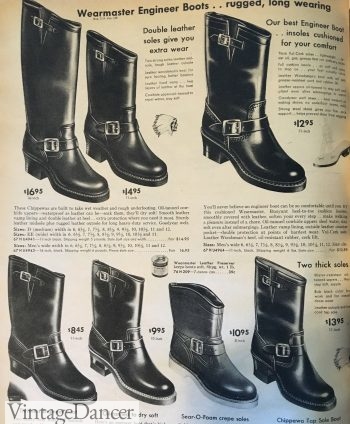
1956 Engineer Boots or Motorcycle boots
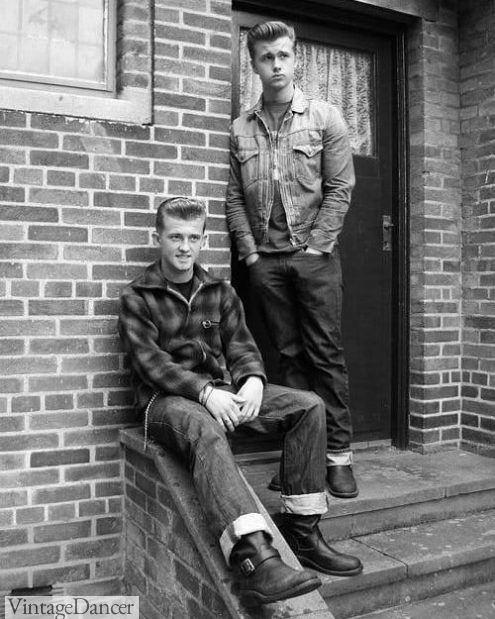
Teens wearing Engineer boots
Pull-on Boots
In 1956 the Australian bush boat was featured in Esquire magazine. It was a smooth, slim half boot with no laces, only two elastic side panels. It hadn’t been popular since the turn of the century, yet here is was again. It would be later called the Chelsea boot and would become an icon of 1960s men’s fashion.
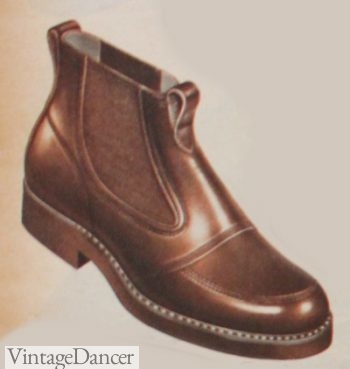
1955 Chelsea Boot
A similar boot, the Chippewa brand pull-on boot was popular with rebels, working men and business class men in winter. Easy to slip into they protected feet from the elements and when worn with long pants looked like dress shoes. They also, would become associated with men’s footwear in the 1960s.
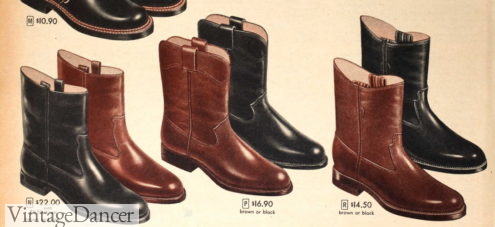
1957 men’s pull on boots
Read more history of men’s winter boots, snow boots and rain shoes.
Chukka Boots & Brothel Creepers
The other unusual young men’s boot of the 1950s was the Chukka boot. They were inspired from desert military boots worn during WWII in North Africa. They are ankle high boots made of suede or leather with a two or three hole lacing. The soles were a thick rubber crepe that protected the foot from the hot sand.
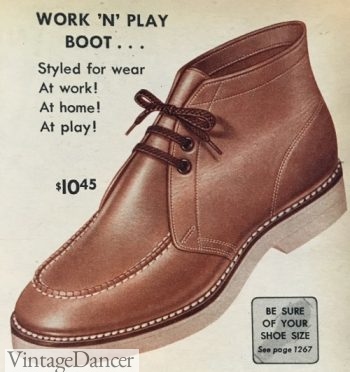
1956 Chukka Boots
When young men returned from war, they continued to wear these very comfortable boots and civilians bought up surplus stock and began wearing them too. Shoe designers took note of the trend and created new shoe designs with a crepe sole.
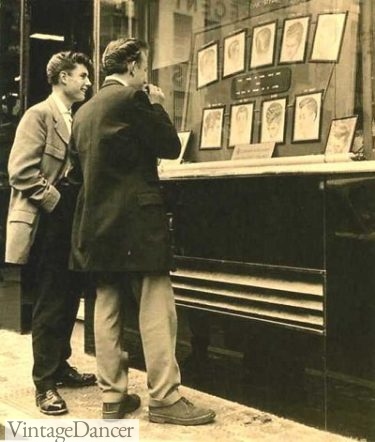
Young rebel types wearing Chukka boots
When young men returned from war, they continued to wear these very comfortable boots and civilians bought up surplus stock and began wearing them too. Shoe designers took note of the trend and created new shoe designs with a crepe sole.
Across the pond, the crepe sole shoe was adopted by British rebels, Teddy Boys. Renamed Brothel Creepers or just creepers, after where Teddy Boys were known to gather, they featured extra thick crepe soles and a low cut suede upper such as an Oxford, loafer, or monk strap design.
One classic design featured two D rings for lace holes and a woven check pattern set within a moccasin top. Black was the most common color.
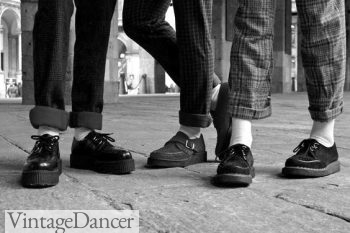
1950s Creepers- Lace up and monk strap styles
The Brothel Creeper mixed design elements with American Rock ‘n Roll rebel shoes to form blends of the two styles. Each shoe designer put their own spin on it in an effort to appeal to the growing youth market.
They have continued to be part of underground culture, adding new designs mixed from the past. In can be tricky to figure out what styles are authentic 1950s creepers and which ones are from the 1970s or 1980s.
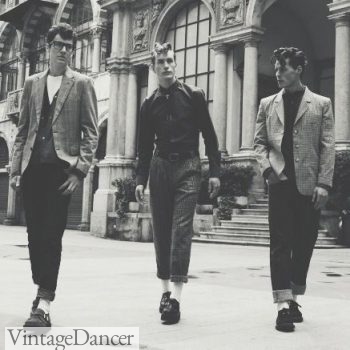
Teddy Boys wearing Creepers
The Brothel Creeper mixed design elements with American Rock ‘n Roll rebel shoes to form blends of the two styles. Each shoe designer put their own spin on it in an effort to appeal to the growing youth market. They have continued to be part of underground culture, adding new designs mixed from the past. In can be tricky to figure out what styles are authentic 1950s creepers and which ones are from the 1970s or 1980s.
Into the 1960s
Continuing into the 1960s, men’s shoes embraced the slim ankle boot, monk straps, and pointy toed winklepicker. Each started its history in the 1950s, but didn’t hit mass market until the mid-1960s.
These are not all of the styles of men’s shoes, but they’re the most common ones worn by middle-class men on a daily basis. Just like today, there were trendy brands and design styles that came in and out of fashion for a few years.
If you grew up in the 1950s, you probably remember some shoes your parents wore. If you were a child in the ’50s then you may have worn children’s version of saddles shoes, bucks, loafers, cowboy boots, or sneakers.
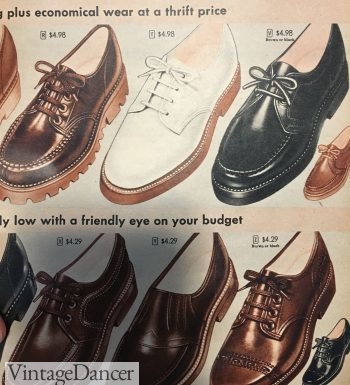
1956 boys shoes – oxfords, bucks, loafers
New 1950s Men’s Style Shoes
While vintage 1950s men’s shoes are still easy to buy in vintage and antique stores and websites like Etsy and eBay, you can also find most styles of 1950s shoes made new today. They may not be exact replicas of vintage 1950s men’s shoes but the cut, colors, and styles are similar enough for most men’s needs.
Check out all the men’s 1950s style shoes I have found online.
Or look at this list of men’s vintage reproduction shoes
Debbie Sessions has been teaching fashion history and helping people dress for vintage themed events since 2009. She has turned a hobby into VintageDancer.com with hundreds of well researched articles and hand picked links to vintage inspired clothing online. She aims to make dressing accurately (or not) an affordable option for all. Oh, and she dances too.
